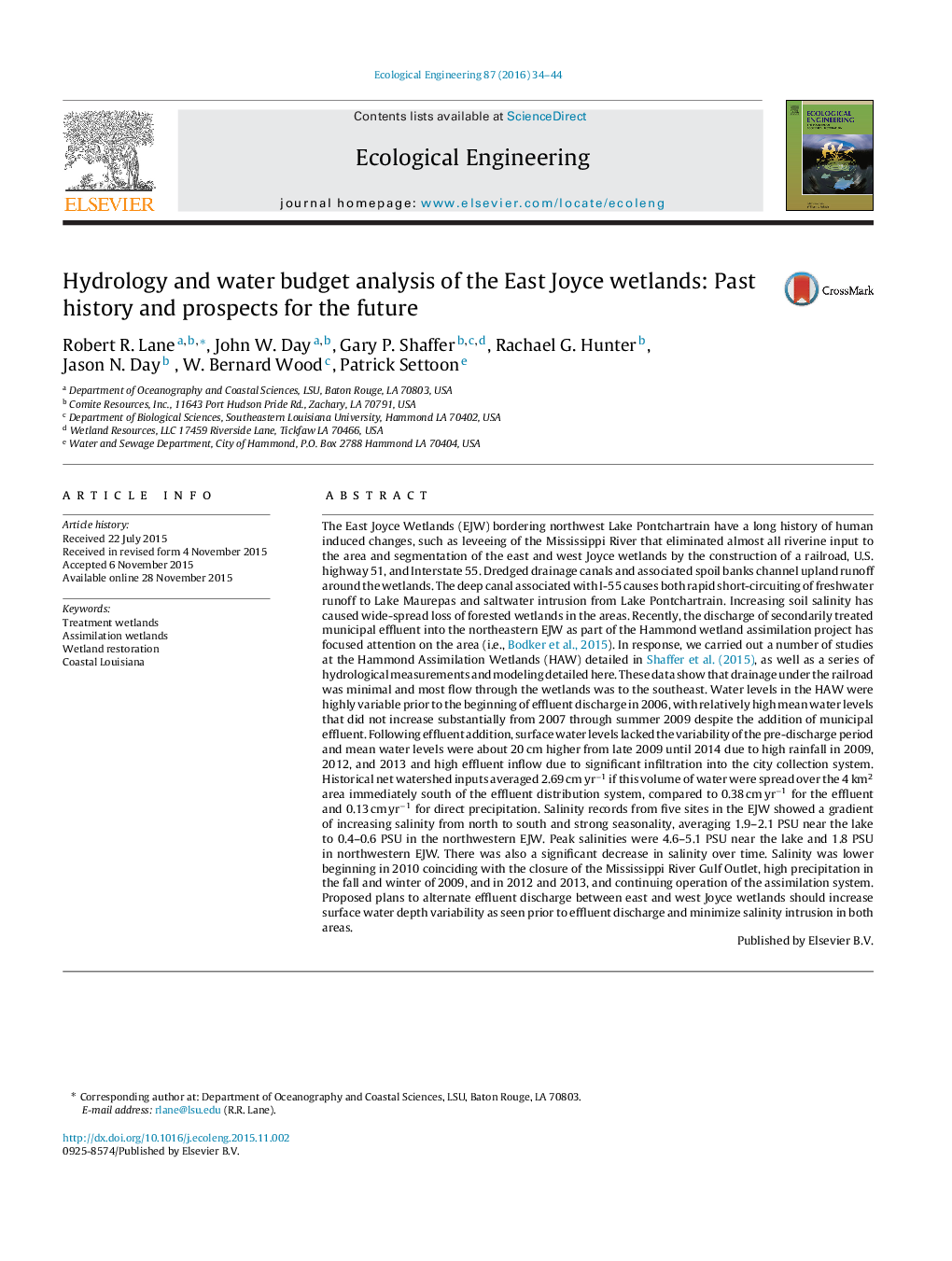| کد مقاله | کد نشریه | سال انتشار | مقاله انگلیسی | نسخه تمام متن |
|---|---|---|---|---|
| 6301432 | 1618012 | 2016 | 11 صفحه PDF | دانلود رایگان |
عنوان انگلیسی مقاله ISI
Hydrology and water budget analysis of the East Joyce wetlands: Past history and prospects for the future
ترجمه فارسی عنوان
تجزیه و تحلیل بودجه آب هیدرولوژی و آب تالاب شرق جویس: تاریخ گذشته و چشم انداز آینده
دانلود مقاله + سفارش ترجمه
دانلود مقاله ISI انگلیسی
رایگان برای ایرانیان
کلمات کلیدی
تالاب درمانی، تالاب همسایه سازی، ترمیم تالاب، ساحل لوییزیانا،
موضوعات مرتبط
علوم زیستی و بیوفناوری
علوم کشاورزی و بیولوژیک
بوم شناسی، تکامل، رفتار و سامانه شناسی
چکیده انگلیسی
The East Joyce Wetlands (EJW) bordering northwest Lake Pontchartrain have a long history of human induced changes, such as leveeing of the Mississippi River that eliminated almost all riverine input to the area and segmentation of the east and west Joyce wetlands by the construction of a railroad, U.S. highway 51, and Interstate 55. Dredged drainage canals and associated spoil banks channel upland runoff around the wetlands. The deep canal associated with I-55 causes both rapid short-circuiting of freshwater runoff to Lake Maurepas and saltwater intrusion from Lake Pontchartrain. Increasing soil salinity has caused wide-spread loss of forested wetlands in the areas. Recently, the discharge of secondarily treated municipal effluent into the northeastern EJW as part of the Hammond wetland assimilation project has focused attention on the area (i.e., Bodker et al., 2015). In response, we carried out a number of studies at the Hammond Assimilation Wetlands (HAW) detailed in Shaffer et al. (2015), as well as a series of hydrological measurements and modeling detailed here. These data show that drainage under the railroad was minimal and most flow through the wetlands was to the southeast. Water levels in the HAW were highly variable prior to the beginning of effluent discharge in 2006, with relatively high mean water levels that did not increase substantially from 2007 through summer 2009 despite the addition of municipal effluent. Following effluent addition, surface water levels lacked the variability of the pre-discharge period and mean water levels were about 20 cm higher from late 2009 until 2014 due to high rainfall in 2009, 2012, and 2013 and high effluent inflow due to significant infiltration into the city collection system. Historical net watershed inputs averaged 2.69 cm yrâ1 if this volume of water were spread over the 4 km2 area immediately south of the effluent distribution system, compared to 0.38 cm yrâ1 for the effluent and 0.13 cm yrâ1 for direct precipitation. Salinity records from five sites in the EJW showed a gradient of increasing salinity from north to south and strong seasonality, averaging 1.9-2.1 PSU near the lake to 0.4-0.6 PSU in the northwestern EJW. Peak salinities were 4.6-5.1 PSU near the lake and 1.8 PSU in northwestern EJW. There was also a significant decrease in salinity over time. Salinity was lower beginning in 2010 coinciding with the closure of the Mississippi River Gulf Outlet, high precipitation in the fall and winter of 2009, and in 2012 and 2013, and continuing operation of the assimilation system. Proposed plans to alternate effluent discharge between east and west Joyce wetlands should increase surface water depth variability as seen prior to effluent discharge and minimize salinity intrusion in both areas.
ناشر
Database: Elsevier - ScienceDirect (ساینس دایرکت)
Journal: Ecological Engineering - Volume 87, February 2016, Pages 34-44
Journal: Ecological Engineering - Volume 87, February 2016, Pages 34-44
نویسندگان
Robert R. Lane, John W. Day, Gary P. Shaffer, Rachael G. Hunter, Jason N. Day, W. Bernard Wood, Patrick Settoon,
